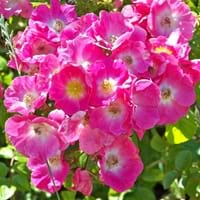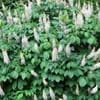Life Span
Perennial
Annual and Perennial
Origin
Southeastern United States
Hybrid origin
Types
Not available
it is a type of rose
Habitat
Bluffs, Coastal Regions, Stream side, Woods
Not Available
USDA Hardiness Zone
5-9
5-8
Sunset Zone
Not Available
A1, A2, A3, H1, H2, 1a, 1b, 2a, 2b, 3a, 3b, 4, 5, 6, 7, 8, 9, 10, 11, 12, 13, 14, 15, 16, 17, 18, 19, 20, 21, 22, 23, 24
Habit
Spreading
Vining/Climbing
Minimum Width
Not Available
Flower Color
White, Pink
White, Pink
Flower Color Modifier
Bicolor
Not Available
Fruit Color
Brown
Non Fruiting Plant
Leaf Color in Spring
Green
Dark Green
Leaf Color in Summer
Dark Green
Dark Green
Leaf Color in Fall
Lemon yellow, Yellow green
Dark Green
Leaf Color in Winter
Not Available
Light Green
Plant Season
Spring, Summer, Fall
Summer
Sunlight
Full Sun, Partial Sun, Partial shade
Full Sun, Partial Sun
Type of Soil
Clay, Loam, Sand
Loam, Sand
The pH of Soil
Acidic, Neutral, Alkaline
Acidic, Neutral
Soil Drainage
Average
Well drained
Bloom Time
Summer, Late Summer
Summer, Late Summer
Tolerances
Salt, Wind
Drought
Where to Plant?
Ground, Pot
Container, Ground, Pot
How to Plant?
Cuttings, Seedlings
Divison, Seedlings
Plant Maintenance
Low
Medium
Watering Requirements
Keep the Soil well drained, Requires regular watering
Water Deeply, Water in morning to avoid prompting diseases
In Summer
Lots of watering
Lots of watering
In Spring
Moderate
Moderate
In Winter
Average Water
Average Water
Soil pH
Acidic, Neutral, Alkaline
Acidic, Neutral
Soil Type
Clay, Loam, Sand
Loam, Sand
Soil Drainage Capacity
Average
Well drained
Sun Exposure
Full Sun, Partial Sun, Partial shade
Full Sun, Partial Sun
Pruning
Remove damaged leaves, Remove dead branches, Remove dead flowers, Remove dead leaves
Prune after flowering, Remove damaged leaves, Remove dead branches
Fertilizers
14-14-14 Fertilizer, Apply N-P-K, slow-release fertilizers
Fast release fertilizer, Fertilize in early spring, Fertilize three times a year
Pests and Diseases
Edema, Powdery mildew, Verticillium Wilt
Aphids, Black Spot, Caterpillars, Downy mildew, glasshouse red spider mite, Insects, Leaf Hoppers, Powdery mildew, rose leaf-rolling sawfly, Rust, Scale
Plant Tolerance
Salt, Wind
Drought
Flower Petal Number
Single
Single
Foliage Texture
Coarse
Medium
Foliage Sheen
Matte
Glossy
Invasive
Sometimes
Sometimes
Attracts
Butterflies, Hummingbirds
Not Available
Allergy
Pollen
Not Available
Aesthetic Uses
Cottage Garden, Showy Purposes
Showy Purposes, Used for decorating walls, fences, gates, hedges, etc.
Beauty Benefits
Not Available
Perfumes
Environmental Uses
Air purification, Wildlife
Air purification
Medicinal Uses
Antirheumatic, Colic, constipation, Piles
No Medicinal Use
Part of Plant Used
Seeds
Flowers, Whole plant
Other Uses
Used for making soaps
Used as Ornamental plant
Used As Indoor Plant
No
Yes
Used As Outdoor Plant
Yes
Yes
Garden Design
Feature Plant, Foundation, Screening, Wind Break
Cutflower, Feature Plant, Groundcover, Hedges, Mixed Border, Rock Garden / Wall, Topiary / Bonsai / Espalier, Vine
Botanical Name
AESCULUS parviflora
ROSA 'American Pillar'
Common Name
bottlebrush buckeye, dwarf horse chestnut
Climbing Rose, Rambling Rose
In Hindi
Bottlebrush Buckeye
Climbing Rose
In German
Buckeye Putzer
Kletterrose
In French
Bottlebrush Buckeye
escalade Rose
In Spanish
bottlebrush Buckeye
Rose que sube
In Greek
bottlebrush Buckeye
αναρρίχηση Rose
In Portuguese
Bottlebrush Buckeye
Rosa de escalada
In Polish
Bottlebrush Buckeye
Climbing Rose
In Latin
bottlebrush Buckeye
Rosa scandere
Phylum
Magnoliophyta
Magnoliophyta
Class
Magnoliopsida
Magnoliopsida
Family
Hippocastanaceae
Rosaceae
Clade
Angiosperms, Eudicots, Rosids
Not Available
Tribe
Not Available
Not Available
Subfamily
Hippocastanoideae
Not Available
Number of Species
Not Available
Season and Care of Bottlebrush Buckeye and Climbing Rose
Season and care of Bottlebrush Buckeye and Climbing Rose is important to know. While considering everything about Bottlebrush Buckeye and Climbing Rose Care, growing season is an essential factor. Bottlebrush Buckeye season is Spring, Summer and Fall and Climbing Rose season is Spring, Summer and Fall. The type of soil for Bottlebrush Buckeye is Clay, Loam, Sand and for Climbing Rose is Loam, Sand while the PH of soil for Bottlebrush Buckeye is Acidic, Neutral, Alkaline and for Climbing Rose is Acidic, Neutral.
Bottlebrush Buckeye and Climbing Rose Physical Information
Bottlebrush Buckeye and Climbing Rose physical information is very important for comparison. Bottlebrush Buckeye height is 180.00 cm and width 180.00 cm whereas Climbing Rose height is 300.00 cm and width Not Available. The color specification of Bottlebrush Buckeye and Climbing Rose are as follows:
Bottlebrush Buckeye flower color: White and Pink
Bottlebrush Buckeye leaf color: Green
Climbing Rose flower color: White and Pink
- Climbing Rose leaf color: Dark Green
Care of Bottlebrush Buckeye and Climbing Rose
Care of Bottlebrush Buckeye and Climbing Rose include pruning, fertilizers, watering etc. Bottlebrush Buckeye pruning is done Remove damaged leaves, Remove dead branches, Remove dead flowers and Remove dead leaves and Climbing Rose pruning is done Prune after flowering, Remove damaged leaves and Remove dead branches. In summer Bottlebrush Buckeye needs Lots of watering and in winter, it needs Average Water. Whereas, in summer Climbing Rose needs Lots of watering and in winter, it needs Average Water.





